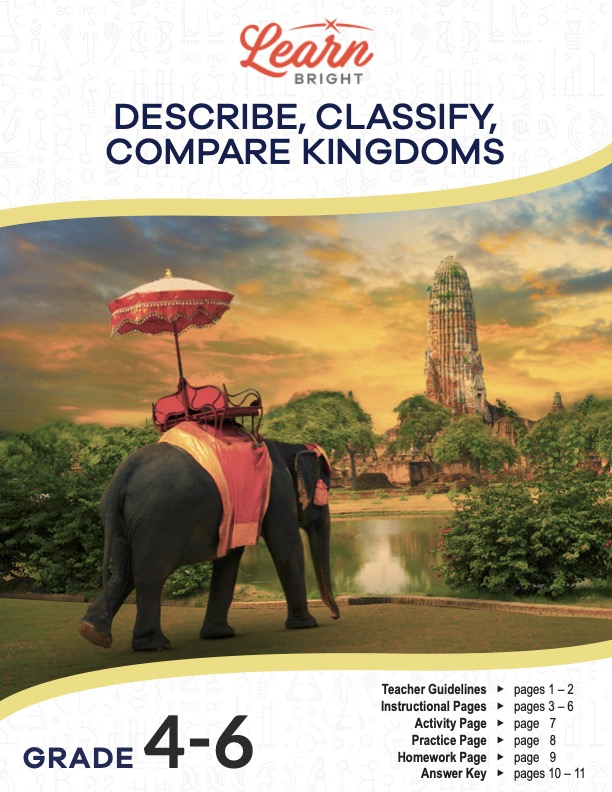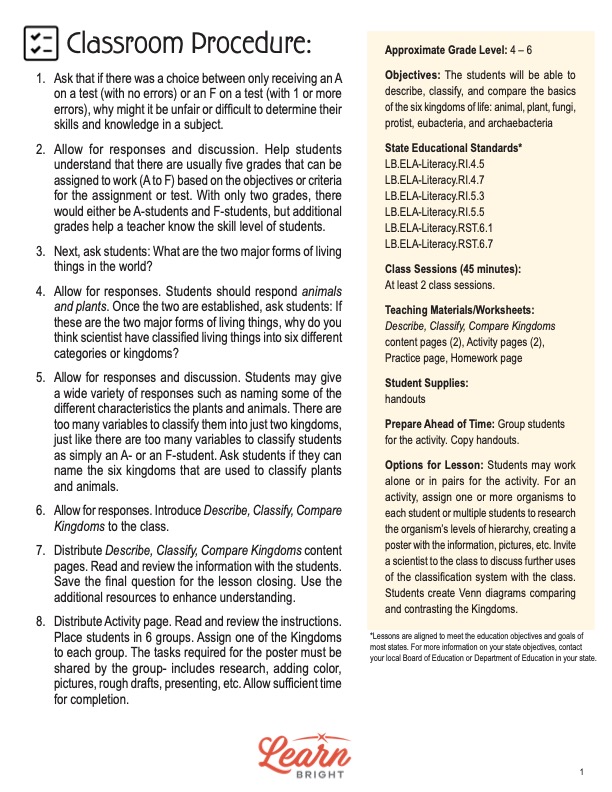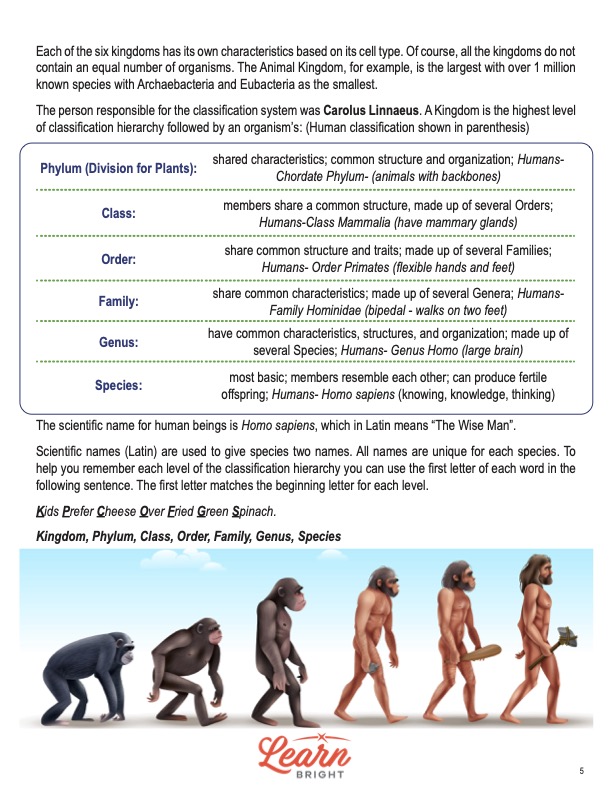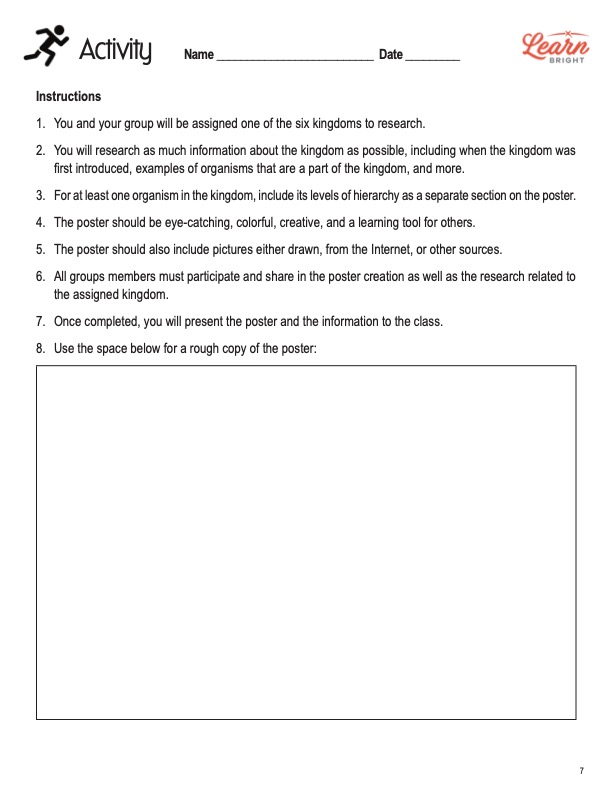Description
What our Describe, Classify, Compare Kingdoms lesson plan includes
Lesson Objectives and Overview: Describe, Classify, Compare Kingdoms explores the living organisms and creatures that fall into each of the six kingdoms. Students will discover which traits organisms share that determine their kingdom. They will also be able to classify creatures by these traits and compare them to each other. This lesson is for students in 5th grade and 6th grade.
Classroom Procedure
Every lesson plan provides you with a classroom procedure page that outlines a step-by-step guide to follow. You do not have to follow the guide exactly. The guide helps you organize the lesson and details when to hand out worksheets. It also lists information in the yellow box that you might find useful. You will find the lesson objectives, state standards, and number of class sessions the lesson should take to complete in this area. In addition, it describes the supplies you will need as well as what and how you need to prepare beforehand.
Options for Lesson
In the “Options for Lesson” section of the classroom procedure page, you will find a few extra ideas or suggestions for additional activities or tasks to incorporate into the lesson. One suggestion is to add an activity in which students research one or more organisms and their levels of hierarchy. Students will create a poster or other type of presentation that includes the information they found as well as pictures or drawings. Another option is to invite a scientist to the class to speak with students about the classification system. One more option is for students to create Venn diagrams to compare and contrast two kingdoms.
Teacher Notes
The paragraph on the teacher notes page provides a little extra information about what to expect from the lesson. It suggests that you focus more on teaching students the basics of the kingdoms than on ensuring they memorize all the vocabulary. Based on students’ readiness, however, you could require that they memorize most of the terms and concepts. The blank lines on this page allow you space to write down additional ideas or thoughts you have as you prepare.
DESCRIBE, CLASSIFY, COMPARE KINGDOMS LESSON PLAN CONTENT PAGES
Classification
The Describe, Classify, Compare Kingdoms lesson plan contains three pages of content. Starting off, students will think about how they sort things they own into different categories and groups. Perhaps they arrange their clothes a certain way, with shirts in one place and socks in another. Their refrigerator might be organized with all the cheeses in one place and all the vegetables somewhere else.
At one time, all the living things in the world were sorted or classified into just two groups (called kingdoms): plants and animals. The plant kingdom included all of the plants, and the animal kingdom included all of the animals. However, the invention of the microscope introduced scientists to new living organisms. They started to identify living organisms according to the differences in the organisms’ cells. This classification of organisms is called taxonomy.
There are six kingdoms now: plants, animals, protists, fungi, archaebacteria, and eubacteria. Scientists classify organisms by cell type (either simple or complex), ability to make food, and number of cells. Each kingdom has its own traits based on cell type. They all have different numbers of species within them as well. The animal kingdom has the most with over a million known species, and the archaebacteria and eubacteria kingdoms have the least.
Taxonomy
The first person to develop this classification technique was Carolus Linnaeus. Kingdom is the highest level in the hierarchy. The lesson includes the remaining levels from phylum to species. It provides information about each level and describes the human classification in parentheses. The remaining six levels from highest to lowest are phylum, class, order, family, genus, and species.
Phylum (or division for plants) refers to the characteristics and common structure and organization of the organisms in the group. Humans are part of the cordate phylum because we have backbones. The members of the same class share a common structure. Humans are part of the mammalia class because we have mammary glands.
On the order level, organisms share a common structure and common traits. Humans belong to the primates order since we have flexible hands and feet. Moving on to family, these organisms share more common characteristics. We, as humans, are part of the hominidae family because we are bipedal, meaning that we walk on two feet.
The last two levels are genus and species. Organisms in the same genus share more common traits, structures, and organization. Humans are in the homo species, meaning that we have large brains. The species level is the most specific. Members of the same species resemble each other and can produce offspring among one another. We belong to the sapiens species because we have the ability to think and have knowledge.
Six Kingdoms of Life
Students will learn a little bit about each of the six kingdoms. The final content page provides a chart with some information about each one. The only characteristic that all the kingdoms share is that they include living things. Every living thing consists of cells (even just one), uses energy, grows and develops, responds to the environment, and reproduces.
Plants include flowering plants, mosses, and ferns. They are multicellular and consist of complex cells. There are over 250,000 species of plants. The organisms in this group are autotrophs, meaning that they make their own food. Animals make up the largest kingdom with over a million species. They are also multicellular with complex cells. However, they are heterotrophs, so they must rely on other substances for food.
Archaebacteria live where hot gases and molten rock boil into the ocean. These organisms are unicellular and live in extreme environments with no oxygen and low acidity levels. Eubacteria are complex, single-celled organisms that include the bacteria we are most familiar with. They have their own kingdom because of their unique chemical makeup. Some eubacteria are helpful and produce vitamins. Others are harmful.
Fungi are multicellular with complex cells and include things like mushrooms, mold, and mildew. These were once confused with plants, but they cannot create their own food. Some are safe while others are harmful. Finally, protists are unicellular with complex cells and include protozoa, algae, and slime molds. They are heterotrophs because they can’t make their own food.
DESCRIBE, CLASSIFY, COMPARE KINGDOMS LESSON PLAN WORKSHEETS
The Describe, Classify, Compare Kingdoms lesson plan includes three worksheets: an activity worksheet, a practice worksheet, and a homework assignment. Each of these pages will help solidify students’ comprehension of the material and help students demonstrate what they learned in different ways. The guide on the classroom procedure page details when to hand out each worksheet to the class.
KINGDOM POSTER ACTIVITY WORKSHEET
You will divide students into six groups for the activity and assign each one a kingdom to research. Students will work together to gather as much information as possible on their kingdom. They should include when it was first introduced, examples of organisms that are part of it, and the levels of hierarchy for at least one of the organisms. In addition, students should include pictures or drawings. The posters should be colorful and creative and able to be use as a learning tool for others. All of the students in the group should participate in creating and presenting the poster. The worksheet provides an empty box for students to use as a rough draft as they design their posters.
CHARTS AND QUESTIONS PRACTICE WORKSHEET
The practice worksheet is divided into two sections. The first section includes a chart with eight prompts—four to compare kingdoms and four to contrast kingdoms. Students must write the similarities and differences between kingdoms according to the prompts. For the second section, students will answer 10 questions that relate to the information on the content pages.
DESCRIBE, CLASSIFY, COMPARE KINGDOMS HOMEWORK ASSIGNMENT
The homework assignment includes three exercises. For the first exercise, students will match descriptions to the correct kingdom. There are 10 descriptions, so students will use a few kingdoms more than once. The second exercise requires students to order the classification hierarchy from 1 to 7. Finally, the third exercise asks students to create a sentence they can use to help them remember the seven levels of classification.
Worksheet Answer Keys
The last two pages of the lesson plan PDF are answer keys for the practice and homework worksheets. All the correct answers are in red to make it easy to compare them with students’ responses. The only question that will contain any variation is the final prompt of the homework assignment. All other responses should mirror those no the answer keys. If you choose to administer the lesson pages to your students via PDF, you will need to save a new file that omits these pages. Otherwise, you can simply print out the applicable pages and keep these as reference for yourself when grading assignments.









